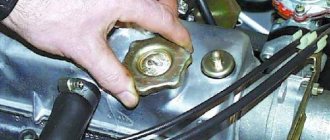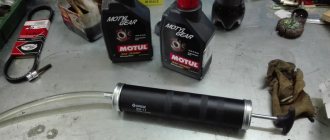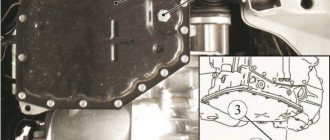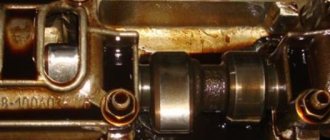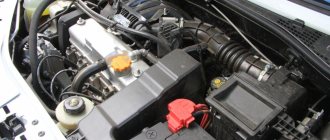Thanks to the close cooperation of the AvtoVAZ concern and Renault, car enthusiasts received a reliable and unpretentious Lada Largus car. This model has become quite popular for many reasons, including functionality, practicality, good build quality and affordable price. Due to the high ground clearance and low overhangs, excellent cross-country ability is ensured, the powerful power plant produces good dynamic characteristics, and the modern steering mechanism, complemented by hydraulic power steering, helps to steer the car with ease.
Characteristics of power steering of Lada Largus
This unit is no less important than the brake system. The safety of the driver and passengers also depends on its performance. Power steering (hydraulic power steering) provides the ability to control the car by easily positioning the drive wheels in the desired direction.
Largus power steering diagram
The Lada Largus is equipped with a combined type hydraulic booster, i.e. some of its elements are located directly in the steering mechanism housing. In other words, they are a component of the mechanical part of the steering column. Power steering Lada Largus consists of a standard set of elements:
- tank;
- power steering pump, complemented by a working fluid bypass valve;
- pipelines;
- redistribution mechanism;
- working mechanism.
There are not many components, which explains the high reliability of the hydraulic booster. Malfunctions associated with its operation occur infrequently. Typically, problems arise due to violations of operating rules by the car owners themselves. Much less often - due to the natural wear and tear of parts, but, of course, one cannot ignore the low quality of components.
Maintenance comes down to following simple rules. The main thing is to regularly check the level of working fluid in the expansion tank of the system. The power steering does not require additional adjustments.
It's easy to check; just open the hood. The fluid in the system is also needed to lubricate the power steering elements. If the level is low, parts will begin to wear out too quickly. With such use, the unit is more likely to fail.
Topping up, phase 3
Under the hood of the latest generation of cars, the tank is located almost under the radiator grille (see photo). The level is controlled along the center line of the tank. There is nothing complicated here.
Power steering reservoir in “phase 3”
As for the choice of material, of all the above options, one is suitable for refilling - ELF Elfmatic G3.
The factory power steering fluid in cars of the Logan 2014 family is the same as in the Lada Largus (MOBIL ATF 52475). We are talking about cars produced by the VAZ plant. By the way, ATF 52475 oil can be diluted with another oil - MOBIL ATF D/M.
The reader understood the meaning of all that was said:
- We are looking for a liter package of MOBIL ATF 52475 material in retail. But this is difficult;
Liquid “ATF 52475”, packaging – plastic
Features of the Lada power steering device
The Largus steering mechanism is conventional, rack and pinion type. It is designed on the principle of a gear moving along a rack, but a hydraulic booster is used to ease the applied pressure on the steering wheel. A similar mechanism is common on most passenger cars. This is explained simply: the design consists of a minimum of parts, the efficiency of the power steering is high. Despite its reliability, the power steering mechanism cannot withstand constant movement over potholes and uneven road surfaces, hence the frequent occurrence of vibrations.
A pump with blades is installed on the power steering of Lada Largus, with the help of which it is possible to move oil in the power steering system. The vane pump is located on the engine, where it is mounted on a bracket and built into the timing drive, i.e. the pump blades are driven by the crankshaft drive poly-V belt. This means that you need to tighten the generator belt in a timely manner, although there is a special tensioner roller for this.
The steering mechanism drive structurally has two steering rods connected to the suspension steering knuckle arms at the front using hinge joints. Unlike other VAZ models, the Largus has a subframe on which the steering rack with power steering is mounted in the boot (on all other VAZ models the steering mechanism is mounted on the engine compartment panel).
During the startup of the power plant, the oil in the Largus power steering system moves from the tank through the pressure created by the pump to the distribution valve. When the wheel is turned in one direction or another, using this valve, one of the power steering cavities is connected to the tubes, and the other to the high pressure pipeline. The power steering piston is connected to the steering rack and drives the gear, as a result of which the rack also begins to move. The movement of the rack to the right or left causes the steering knuckles to turn, thus making a turn to the right or left.
Damage to the power steering does not particularly affect the ability to drive the car. The only drawback is the significant increase in effort when necessary to turn the steering wheel.
How much to fill
Unlike other LADA models, the refueling volumes of Lada Largus are not presented in the operating manual. Data for the Lada.Online website was provided by one of the LADA dealerships.
| Unit | Volume, l |
| Engine lubrication system -11189 -21129 (cast oil sump) -K7M -K4M | |
| Power steering system (power steering) | 1,2 |
| Hydraulic brake system | 0,7 |
| Air conditioning system with R-134a refrigerant | 0,475 |
Problems due to low fluid level in the power steering system
There can be many power steering malfunctions on any car, since the design and operating features of the parts imply natural wear and tear. Some things are related to low fluid levels. The main sign indicating an insufficient oil level in the power steering is the need to make significant efforts when turning the steering wheel or a creaking sound when turning the steering wheel of the Lada Largus. This may also indicate a drive malfunction or contamination of the working fluid.
Also, a low fluid level can be confused with a pump malfunction. If there is not enough working fluid in the system, the pump will not be able to pump the required amount of oil into the distribution valve and the actuator will not be able to distribute the load, which will immediately affect the need to apply more force to the steering wheel when turning.
A low power steering fluid level is also accompanied by air entering the system. Air bubbles lead to a decrease in operating pressure in the power steering system. A similar problem also arises due to loss of system tightness. The problem will also be reported by the indicator on the control panel, which transmits readings from the oil level sensor to the power steering.
A decrease in oil level in the power steering system is most often a consequence of a leak. This is one of the most important power steering problems that car owners face. Most often it appears at the point where tubes are connected to parts of the system, for example, to a pump. Leakage also occurs due to damage to the tubes or loss of elasticity of the rubber sealing elements; usually such gaskets are used in all connections of the hydraulic booster system. To eliminate a leak, you must first find the location of the leak; in the case of joints, it is enough to tighten them properly. If the leak is due to damaged tubes, they should be replaced.
Things are more complicated with damaged or worn sealing elements. The main problem is the labor-intensive process, since it is necessary to remove the leaking unit and repair it with replacement of rubber sealing elements. In advanced cases, extraneous sounds occur, indicating failure of the power steering components, and a grinding noise appears when turning.
Comments
TOP materials of the week
TOP products in the store (more)
Who services your Lada Largus?
Lada.Online
Lada (“Lada”) is a brand of cars produced by JSC AVTOVAZ. Previously, it was used only for export cars, and for the domestic market, cars were produced under the Zhiguli brand. In 2004, the management of AVTOVAZ announced the transition to the Latin alphabet for the official spelling of the names of all cars produced by the plant: Lada - instead of "VAZ" and "Lada".
Lada.Online is the largest Russian-language automotive resource with a daily audience of thousands, which is dedicated primarily to cars of this brand, the domestic automotive industry and the automotive world in general.
This site is not the official LADA website.
© 2022 Lada.Online. Copying of material is permitted only with a link to the source.
Source
Factory oil and selection rules
Since the Lada Largus is actually an analogue of the Renault Logan, power steering oil from the French model is suitable for this car. In turn, this is confirmed by the manufacturer Largus.
What is recommended to use to replace power steering fluid on Lada Largus
| Conditions | Brand |
| Oil like the “French” Renault Logan has the best viscosity and density indicators, created taking into account operation in Russian conditions at temperatures down to minus 40 degrees, and this turns out to be quite enough for use in the middle zone. | Synthetic or semi-synthetic oil based on the D2 ATF standard, as well as PSF. |
| Pay attention to the service book. | The oil listed there is ELF RENAULTMATIC D2. |
| If the vehicle is actively used and the load on the steering mechanism is significant or the vehicle is used in areas with extremely low temperatures. | In this case, it is recommended to use oil marked D3 or Elf RENAULTMATIC G3. |
In addition to these brands of power steering fluid, the manufacturer recommends some analogues that are as close in their characteristics as possible to the original:
- Mobil ATF 220 or 320;
- Castrol ATF D2 or D3;
- Liqui Moly ATF 1100.
When changing power steering oil yourself, you should keep in mind that you should never mix fluid of different brands.
The result of such mixing will be foaming of the oil and, as a result, failure of the power steering. To replace, you must use the full volume of working fluid. Only compliance with such simple rules and recommendations for monitoring the oil level and choosing the right brand will ultimately lead to stable operation of the entire steering system as a whole. This way you can save money on expensive repairs, and also significantly reduce the risk of getting into an accident due to a faulty steering mechanism.
What technical fluids are filled from the factory?
The information below was provided by the official LADA website.
Engine oil to the engine
:
Transmission oil in the gearbox (gearbox)
:
Coolant (antifreeze)
:
Attention!
This information is for reference only and may be changed by AVTOVAZ without prior notice to the Buyer. For information on recommended working and lubricating fluids, we recommend contacting an official LADA dealer.
Still have questions? Ask in the comments!
Other background information on Lada Largus is provided here.
Share on social networks:
Found an error? Select it and press Ctrl+Enter..
Changing power steering oil on Lada Largus cars
Sooner or later, the system requires replacement of the working fluid, just like in the engine. According to technical regulations, power steering oil filled at the factory is designed for a mileage of no more than 40,000 kilometers or for 2 years of vehicle operation.
Replacement before due date
Changing the working fluid once every 40 thousand kilometers does not mean that you can forget about it and not periodically check its condition in the system. An unscheduled power steering oil change is required in the following cases:
- metal particles in liquid;
- darkening of oil;
- foreign odors.
The reason for replacing the fluid may also be a decrease in its level in the system due to a leak. This is due to the fact that a low oil level in the power steering system causes it to heat up excessively, and this leads to failure of the main power steering components. If the car has not been used for a long time, the oil in the power steering must be changed, since there is a high probability of condensation forming during this time, and this causes the formation of an emulsion. Accordingly, the liquid loses all its basic properties and cannot be used for its intended purpose.
Oil change instructions
Any car owner can change the working fluid in the power steering system. There is nothing complicated here, and there is no need to contact a car service. Do-it-yourself oil change work begins with preparing the following tools and materials:
- about two liters of oil recommended by the manufacturer;
- 20 cc syringe milliliters and a tip with a hose to it;
- socket wrenches;
- a suitable container for draining old oil.
Before starting the replacement procedure, the engine should be warmed up to operating temperature. Then use a syringe and a hose to pump out the liquid from the expansion tank. The further process is as follows.
- The car is installed on an overpass or above an inspection hole; if this is not possible, you can simply lift the front part with a jack.
- Remove the battery and additionally its casing.
- To get to all the necessary pipes at the steering mechanism, you need to remove all the interfering plastic parts.
- Inspect the entire power steering system, thereby identifying any leaks or cracks on the expansion tank.
- Since the liquid has been removed from the tank, it can be dismantled by removing it from its mounts.
- The tube going to the power steering on the steering mechanism is disconnected from the reservoir; be sure to close the fitting on which the tube was installed.
- Finding a drain pipe is not difficult: its size is smaller. After which it is lowered into a suitable container prepared in advance.
- Next, you will need the help of a second person. The assistant must, while in the cabin, turn the steering wheel to the right and left all the way. The waste liquid will be drained into the container. To speed up the process, you can start the propulsion system.
- When draining the fluid, you must remember not to allow air to enter the hydraulic booster system. To avoid such situations, a second person should periodically add oil to the tank. If there is no assistant, you cannot start the engine. It is enough to rotate the steering wheel in both directions until all the liquid has drained from the pipe.
After draining the old fluid, new oil is poured into the tank and the engine starts. Now you need to turn the steering wheel in both directions to the extreme positions. Periodically you need to monitor the fluid level in the tank. When decreasing, add oil and continue manipulating the steering wheel until the level in the tank stops falling and air bubbles appear. After replacement and testing, all that remains is to assemble all the plastic parts and install them in place, then once again check the tightness of the clamps on the connections.
When the power steering fluid is correctly replaced, the steering wheel rotates easily and without the need to apply force (with the engine running).
Reviews
Grigory, Dnepropetrovsk. I drove 110 thousand km on Largus, the car is still holding up. A decent workhorse that is worth the money. This van has paid for itself a long time ago and brings in a stable profit. I give a thumbs up to comfort and multimedia options, as long as the suspension can withstand the loads being transported from point A to point B. The VAZ 1.6 engine consumes around 11 liters in the urban cycle.
Vladimir, Lipetsk region. My wife has a Logan, and I have a more practical seven-seater Largus, suitable for forays into nature over rough terrain. The main advantage of Largus compared to the previous Logan is a lot of space. And in this regard, the station wagon simply cannot have competitors for that kind of money. The unpretentious 1.6-liter engine never fails, the main thing is to fill the oil and filters on time. Average consumption 9 l.
Source
Why you can’t save money when choosing power steering fluid
When choosing power steering fluid, you should pay attention to well-known manufacturers of car accessories. It is better to purchase such consumables in specialized stores for car enthusiasts, since they directly affect traffic safety
Low-quality power steering fluid may have the following disadvantages: Loss of properties at elevated temperatures. During operation, the power steering fluid on some cars “heats up” above 100 degrees Celsius. Oil with poor quality additives may begin to coagulate at such high temperatures that it will cause difficulty turning the steering wheel. Particularly low-quality power steering fluids can completely damage the power steering at high temperatures. In such a situation, the steering will continue to work, but after that the driver will have to repair the power steering elements;
Release of hazardous fumes for vehicle occupants. The amount of chemical reagents mixed into power steering fluid is no less than in car additives. At elevated temperatures, power steering fluid emits vapors that can be hazardous to the health of passengers. If you purchase such oils in specialized stores and from trusted brands, you don’t need to worry about harmful vapors, while in an effort to save money when purchasing secondhand, you can end up with a liquid containing harmful or even dangerous elements.
Anti-lock braking system performance
Thanks to the presence of ABS in the braking system, it is possible to significantly reduce the braking distance, which allows the driver to maintain good vehicle control in emergency braking conditions. This allows you to avoid many unforeseen situations and makes it possible to maneuver during braking. These advantages make the anti-lock braking system an important element of the braking system.
The presence of ABS in the car is better for an inexperienced driver in any case; it allows emergency braking even in an intuitive way, applying maximum force to the brake pedal, while maintaining the ability to maneuver.
Among the many advantages of the anti-lock braking system, according to experts, there is only one drawback - braking the car on loose areas (gravel, sand, high snow). The braking distance becomes much longer than when the wheels are completely locked, since the car does not “bury itself” in the loose surface, but continues to move normally. However, today modern ABS already have algorithms that are successfully used when braking even on such surfaces.
When is a formal replacement required?
According to the manufacturer, it is advisable to change the power steering oil for the first time after 40 thousand kilometers or after two years of Renault operation. During the same period, the unit is inspected and, if necessary, faulty elements are repaired. But, despite such recommendations, the working fluid may require earlier replacement.
You can talk about replacement if the following symptoms appear:
- Unpleasant stench.
- Darkening of power steering oil.
- The appearance of small metal shavings (garbage) in the composition.
In the mentioned cases, subsequent inspection of the hydraulic booster elements and repair of failed components may be required. If you do not fill in the working fluid (when the level drops) or do not change the composition with the symptoms mentioned above, then the temperature of the lubricating fluid increases, as does the risk of failure of the entire mechanism. In the future, more serious costs for repairing the Renault Logan power steering cannot be avoided. The downside is that the hydraulic boost stops working normally, and it is more difficult for the driver to steer, which increases the risk of getting into an accident.
Application area
Mobile ATF 52475 transmission oil can be used in any automatic transmission of passenger cars, SUVs, mini-trucks, and also as a power steering fluid if it meets the manufacturer's approvals.
Approved for use in Allison C-4, Ford Mercon, General Motors Dexron III transmissions. This oil for transmissions and power steering is recommended by Mercedes-Benz, Renault, MAN and LADA LARGUS, LADA X-Ray. In particular, this fluid is poured into the power steering on the Lada Largus at the factory.
Can be used in any climatic and road conditions, including extremely difficult ones.
Lada Largus “White Barge” › Logbook › Replacing the brake fluid.
Why I did this, I don’t know))) I haven’t done this on purpose on any machine. The procedure is not complicated. I pumped out the brake fluid from the reservoir with a syringe.
The liquid is slightly blackish.
Added fresh fluid. I hung the wheel up with a jack. On the bleeder valve I put a 8mm spanner and a transparent hose, which I lowered into a bottle with drained liquid.
He unscrewed the valve and began to smoothly pump the pedal, refilling the barrel from time to time. I carried out this procedure with each wheel. The fluid drained from the system was quite clean.
This tool was needed to replace it.
I started to start the engine and forgot that the car was at speed)))) As a result, the car would no longer start. The strange thing is that this time even the tape recorder was not working the whole time I was studying. It's time to change the battery. Ordering online is more powerful, I’ll pick it up tomorrow.
Started the car using batteries from my wife's wheelchair)))
Types of ABS systems
Before you take steps to bleed ABS brakes, you should familiarize yourself with it. At the moment, there are two main types of ABS, which differ from each other in the main feature - the order in which the system components are placed.
1) The first type of ABS - the main unit contains the pump itself, a block of hydraulic valves, and a hydraulic accumulator.
The steps for bleeding the brakes occur in a sequence similar to bleeding as in a car with conventional brakes without an anti-lock system.
It is necessary to find the fuse responsible for the operation of the car’s ABS and remove it, thereby achieving a complete shutdown of the system. Find the RTC bleeder fitting and unscrew it. Further bleeding of the ABS brake system should be carried out strictly with the brake pedal depressed. Turn on the car ignition, but the ABS fault light should light up. At the same time, the pump starts, expelling air from the brake system. An extinguished brake light means that everything was done correctly.
2) The second type of ABS - all the components (hydraulic accumulator, hydraulic module with valves) of this system are located in different units.
You will need a special scanner that diagnoses the ABS system and retrieves all the necessary information from the electronic control unit of the brake system.
Such a scanner is quite expensive and is rarely found among car owners, which is why bleeding of brakes with ABS is usually carried out in a service station. Most ABS are equipped with activation devices SBC or ESP, just like ABS they are pumped only at service stations.
Selection of the best oils for Lada Largus
Shell
PC 1448 0W-30 PC 1021 0W-30 Helix Ultra 5W-40
ELF
Excellium NF 5W-40 Solaris MSX 5W-30 Evolution SXR 5W-40 Evolution 900 FT 0W-30
Lukoil
Genesis RN 5W-40 Luxe SN 5W-40
Nissan
Oil 5W-40
G.M.
Dexos 2 5W-30
Kixx
NEO 0W-30
ROLF
JP 0w-30
MANNOL
ENERGY JP 5W-30 7701 OEM 5W-30
CHAMPION OIL
SPECIFIC 5W-30
CHEMPIOIL FOR NISSAN
STRONG SAVE-X 5W-30
DRAGON
SEVEN SN 0W-30
GAZPROM
PREMIUM L 5W-30
G-energy
F Synth 5W-30
GT-oil
Energy SN 5w-30
Which manufacturer is better, what to choose?
I have prepared many thematic ratings for my site, based on comparing reviews by brand and comparing laboratory analyzes of each model. I recommend checking it out. It's better to see once than to hear 100 times. There is never a clear answer.
- Car oil rating 5w-30
- Rating of oils for winter 0w-20, 0w-30, 0w-40
Principle of operation
The operation of the anti-lock braking system is based on the laws of physics, mainly the law of friction. From 7th grade physics we know that static friction resistance is greater than sliding friction resistance. Based on this, we conclude: the braking distance of rotating wheels is shorter than skidding ones. But the margin for keeping the wheels in a spinning position, especially on uneven surfaces, is so small that even experienced drivers sometimes cannot cope with it. And ABS easily performs the task. How does it work?
As soon as the driver presses the brake pedal all the way, he will feel the characteristic sound of a “ratchet” and pulsation emanating from the pedal, which means the ABS has started working. Now the braking process is controlled not by the driver, but by the system ECU. Sensors read wheel speed and brake line pressure.
The computer calculates the required rotation deceleration rate for a given situation and sends a command to the modulator to close one or another brake circuit. When the deceleration rate coincides with the design one, fluid access to the brake circuit is resumed. This operation for each circuit is performed from several to 18-20 times per second, preventing wheel locking.
The driver can only continue to maneuver under ideal braking conditions, while the ABS slows down the car.
Removal
- Set the steering wheel straight.
- Squeeze the airbag module mounting clips while inserting the rods into the holes located on the sides of the steering wheel.
- Pull the airbag module along with the horn switch from the steering wheel towards you to the length of the wires connected to it.
- Disconnect the block with wires from the airbag module, first removing the clamp (pry it off with a screwdriver).
- Remove the airbag.
- Mark the position of the steering wheel hub relative to the shaft.
- Remove the steering wheel mounting bolt, holding the steering wheel from turning.
- Remove the steering wheel by pulling it towards you.
- When removing the steering wheel, carefully remove the wiring harness of the steering column switch unit to the airbag module through the hole in the hub.
To avoid damaging the current-carrying busbar of the airbag contact ring, secure the ring against rotation by inserting a piece of thin plate into a special groove.
Main power steering problems and solutions for them
The Renault Logan steering rack with power steering is a fairly reliable unit that rarely fails. If you monitor the hydraulic booster, this system will not bother the car owner. In order to prevent breakdown of the unit, it is necessary to timely identify malfunctions in its operation and, accordingly, promptly repair the system. Every car owner should check the level of the substance in the tank from time to time - if it drops, this indicates the need for diagnostics.
What problems are typical for the amplifier:
- Oil leak. This malfunction may be associated with a breakdown of the fluid pressure sensor; replacing the device will solve the problem. Also, leakage of consumables may be caused by mechanical damage to the expansion tank or the hoses themselves. There may be oil leakage through the connectors.
- The driver needs to exert significantly more effort to rotate the steering wheel. In this case, it is necessary to carry out diagnostics to determine the breakdown. If the force to turn the steering wheel is excessive and uniform, then perhaps the reason lies in the drive belt; it should be checked first. Perhaps the strap is worn out or stretched, then it will need to be replaced with a new one. If the condition of the belt is normal, then you need to do more detailed diagnostics. As practice shows, it may be that such symptoms are caused by malfunctions in the suspension elements or mechanical components of the steering system. It is necessary to more carefully check the ball joints, steering pins, as well as the performance of the steering rack and other elements.
- If jerking occurs when turning the steering wheel, this may indicate an air lock in the system, insufficient pressure, or a stuck camshaft valve. It should be noted that the formation of an air lock in the system may be due to a breakdown of the pressure controller. If one of the constituent elements leaks, this can lead to air entering the power steering.
- The inoperability of the amplifier may also be due to a pump failure. This problem occurs quite often; usually, if the pump breaks down, you have to install a new unit.
Power steering pressure sensor
Level check
You should start by checking the brake fluid level in the expansion tank of the ABS system. To do this, you need to look under the hood of the car, find the tank located on the rear wall of the engine compartment, and check the fluid level in the vacuum tank, which should be approximately in the middle of the MIN and MAX marks located on the side of the tank. If the level is below the minimum, then the fluid is leaking somewhere and you should go to a service station to determine the cause.
You should pay attention to the color of the liquid, which can vary from light yellow to dark brown. Since brake fluid darkens during vehicle operation due to impurities appearing in it, a dark brown fluid indicates that it needs to be completely replaced in the near future.
There should also be no burning smell or other foreign odors.
